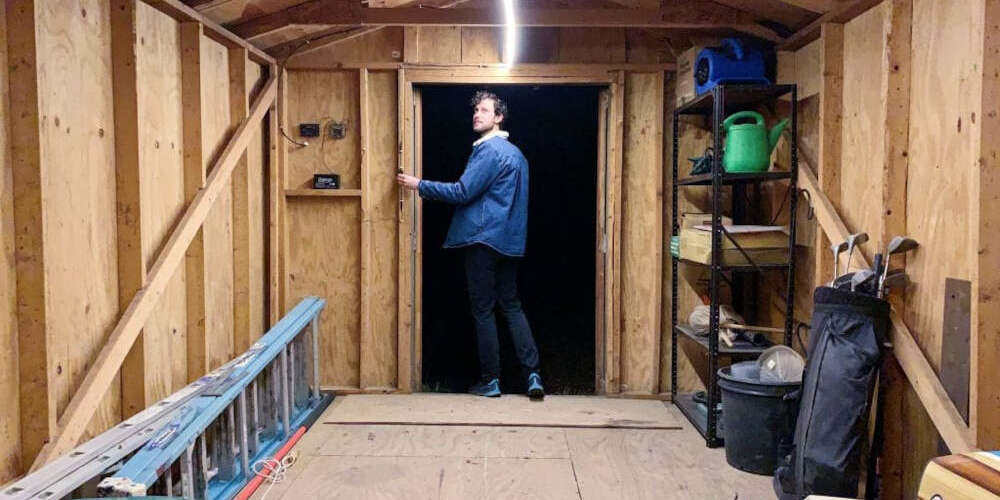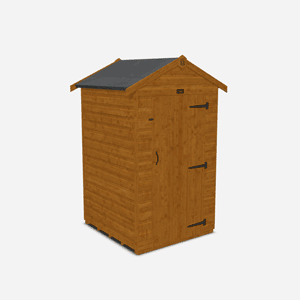How to Light a Shed, Summerhouse or Log Cabin
Published: 04/10/2021

Whether you want interior shed lighting or outdoor lights, knowing your options can save you time and money, while also making your shed a much nicer place to spend time. And that’s why we’re writing this article – to give you shed lighting ideas (and to help you choose between them!).
Note: If you’re looking for information on wiring your shed, check out our post on how to wire a shed for lights and outlets. Or if you want to learn about installing solar power for garden shed lighting, read our article on solar panels for sheds.
So, how do you light a summerhouse, log cabin, or shed? Well, there are lots of ways to achieve this. But before we get into this, you need to work out how much light you need…
How much light do I need in my shed? What to consider
Good question – and we’ll get into the technical stuff later in this section. At this point, it’d be wise to think about the different elements that’ll influence how much light you need in your shed:
How much natural light you get

As an abundant natural resource that’s also freely available, natural light is arguably the best option. As long as your shed has windows, you can take advantage of (at least some natural light).
Even if you have the budget for the most expensive, high-powered artificial shed lighting, it’s worth thinking seriously about natural shed lights. Why? Because studies show that natural light can improve your mood and reduce eye strain [1].
Which leads us on to the next point…
The location of your shed

If your shed has windows and you live in the UK (or in the northern hemisphere), you’ll get the most natural light during the day if your windows are facing south [2].
If the windows on your shed aren’t positioned in a southward direction, we recommend moving your garden building to achieve this.
How much time you spend in your shed (and what you use it for)
This is possibly the most important factor to consider when lighting your shed. This is because if you have a log cabin you use a garden office where you spend eight hours of your day, practicality, comfort, and cost are important considerations.
But by contrast, you’re less likely to be concerned about how shed lighting affects you or your bills over long periods if you just need to see what you’re doing. For example, when you’re pulling garden tools out of your storage shed.
Your budget

As different shed lighting options vary in terms of cost, your budget is also something you need to consider. To save money, this may mean swapping your 240v incandescent bulbs for LED strip lights, for example (more on this later).
In the next part of this article, we go into how to calculate lumens…
How many lumens do I need to light a shed?
As we state earlier in this post, the number of lumens you’ll need to light your shed depends on how you intend to use it.
According to the Illuminating Engineering Society’s Lighting Library, this is what you’ll need in different situations [3]:
- Shed with ambient lighting: 50 lumens per square foot
- Work bench: 300 lumens per square foot
- Task lighting: 300 lumens per square foot
- Accent lighting: 75 lumens per square foot
Taking the above figures into account, let’s imagine you have a 5’ x 2.5’ bench in your workshop shed you want to light. 5 multiplied by 2.5 is 12.5, which means there are 12.5 square feet in the area you want to light.
12.5 multiplied by 300 is 3750. So, to light your working area, you’ll need 3750 lumens. This will allow you to carry out intricate tasks at your workbench for a prolonged period.

Electrical options
If you want to know how to wire a shed for lights and outlets, read this post. But in this article, we’re talking more about shed lighting options that need electricity to run.
Incandescent, fluorescent, and LED bulbs

There are a few examples of bulbs hat may be good as interior shed lighting. Two popular types are the 12v bulbs and 240v strip lights.
In the case of 12v bulbs, each one usually sold individually, whereas 240v strip lighting usually features several bulbs in strips (hence the name). So how do you choose between incandescent, fluorescent, and LED bulbs?
We would recommend LED lights. Why? Because they’re the most energy efficient – meaning they give you lower operating costs than either fluorescent (CFL) or incandescent bulbs.
The other advantages (and main disadvantage) of LED shed lights
One advantage that fluorescent lighting used to have over either individual 12v LED bulbs or LED strip lights was that they were omnidirectional – meaning that if you wanted to light a whole room (for example), the fluorescent light could do that, whereas the LED light could not.
However, omnidirectional LED lights are now available. So, while LED lights used to better for providing light for specific tasks, they are now more versatile – especially since you can also buy 240v LED strip lights.
That said, standard LED bulbs tend to be unidirectional – which means the light moves in a single direction and can create unwanted shadows. To reduce this issue, you can increase the number of bulbs you use.
Hardwired vs plug-in shed lights
Hardwiring lights takes more time and money to install than plug-in shed lights. So, if budget is an issue, a plug-in version may be the best option. However, hardwired lighting is tidier with fewer wires getting in the way.
How do you light a shed without electricity?
There are a few ways to light your shed without electricity, including the following:
Natural light
We mentioned natural light earlier in this post – and that’s because it can save you a lot of money and ensure you stay comfortable in the shed. Again, as we say earlier in this piece, we recommend ensuring that your windows face south to take advantage of the sun’s movements.
If you have a north-facing shed (and there’s nothing you can do to change this), you may wish to consider installing more windows – or even buying a new shed.
Too much of a good thing can be a bad thing
If your shed sits in a spot that gets a lot of direct sunlight, consider install curtains or blinds to provide some much-needed shade on hotter days.
That said, natural light should still be top of your list when it comes to providing light for sheds without power.
Solar power shed lights

“Ah, but solar panels generate electricity,” I hear you say. That’s right – but in this section, we’re referring to how to run lights off the grid (not wired to the mains). And that’s why we also talk about battery shed lights (more on this later).
From standalone lights to whole lighting systems powered by solar panels on your shed roof, solar-powered lights are eco-friendly and very cheap to run.
What type of solar-powered equipment should you buy?
That depends on your needs. For example, if you just need a couple of outdoor shed lights, a couple of standalone solar lights should suffice.
But if you’d like to power tools and equipment for several hours at a time, a full solar panel kit may be in order. To learn how much power you’ll need for your specific purposes, read our article called Solar Panels for Sheds: What You Need to Know.
With the right solar panels, you can obviously power the plug-in shed lights or hardwired lights we talk about earlier in this post.
Battery-powered lighting

Lights tend to be power hungry and can run batteries down quickly if used constantly.
However, if you need outside shed lights that act as either an anti-theft measure or as a way to see more clearly when entering or leaving your shed in the dark, you can buy battery shed lights with motion that turn themselves on and off automatically. They can also be useful as task lights.
A rechargeable shed light can also eliminate the cost of replacing batteries.








